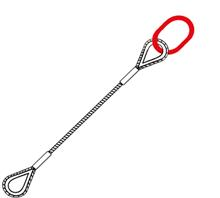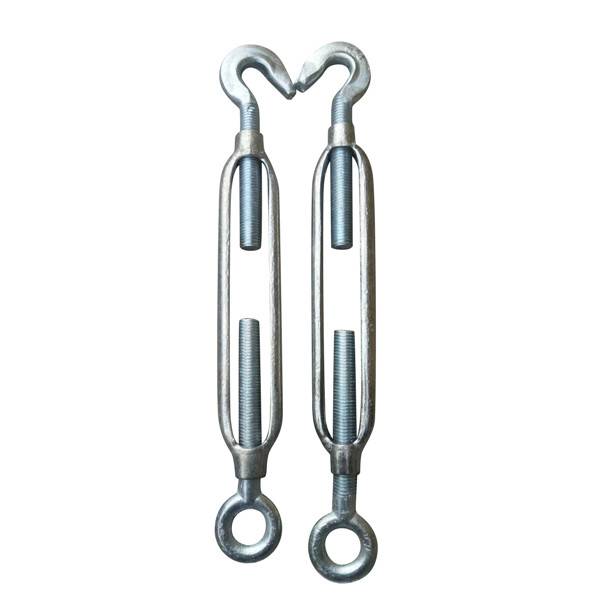Pressed wire rope sling

| Art.No. | Dia | WILL | A×B |
| (mm) | (kg) | (mm) | |
| ZS0202006 | 6 | 320 | 60×120 |
| ZS0202008 | 8 | 560 | 80×160 |
| ZS0202009 | 9 | 710 | 90×180 |
| ZS0202010 | 10 | 880 | 100×200 |
| ZS0202012 | 12 | 1250 | 120×240 |
| ZS0202013 | 13 | 1500 | 130×260 |
| ZS0202014 | 14 | 1700 | 140×280 |
| ZS0202016 | 16 | 2200 | 160×320 |
| ZS0202018 | 18 | 2800 | 180×360 |
| ZS0202020 | 20 | 3500 | 200×400 |
| ZS0202022 | 22 | 4200 | 220×440 |
| ZS0202024 | 24 | 5000 | 240×480 |
| ZS0202026 | 26 | 6000 | 260×520 |
| ZS0202028 | 28 | 7000 | 280×560 |
| ZS0202030 | 30 | 8000 | 300×600 |
| ZS0202032 | 32 | 9000 | 320×640 |
| ZS0202036 | 36 | 11000 | 360×720 |
| ZS0202040 | 40 | 14000 | 400×800 |
| ZS0202044 | 44 | 17000 | 440×880 |
| ZS0202048 | 48 | 20000 | 480×960 |
| ZS0202052 | 52 | 24000 | 520×1040 |
| ZS0202056 | 56 | 27500 | 560×1120 |
| ZS0202060 | 60 | 30000 | 600×1200 |
Pressed Flemish Eye Galvanized Wire Rope

Pressed wire rope sling with multiple legs
classification:
- Press one end or both ends into a circular ring.
- Rigging with single, double, three, four or more limbs can be made according to requirements
Application :
Suitable for transformer, shipbuilding and special machinery and a variety of environment in large lifting special requirements.The minimum breaking force of wire rope without joint is 6 times of the working load.
Note :
In ordering a wire rope sling be sure to give complete information including length, diameter, construction, lay, core.
Length: state the exact length desired. In ordering end fittings such as thimbles,links or hooks spliced in, give exact length from bearing to bearing or end rope, or submit a sketch with dimensions.
Diameter: the true diameter of a wire rope is the diameter of a circle which will enclose it. In using the caliper to determine the diameter, be careful to avoid measuring across the adjacent strands.
Construction:advice whether 6X19,6X37,7X19 or other.
Lay:state definitely whether regular(right hanad or left hand). or lang lay(right hanad or left hand)is required; if it is uncertain,consult with us. Standard practice is to furnish Right Hand Regular(ordinary)Lay. But if left hand Regular(ordinary)Lay is required for cable tool drilling or some other purpose, be sure to state.
Core:indicate whether fiber core(FC)or independent wire rope core is desired.
What is a lifeboat wire rope sling, and what is its purpose?
A lifeboat wire rope sling is a type of lifting sling made from wire rope that is specifically designed and used for the purpose of lifting lifeboats.
The purpose of a lifeboat wire rope sling is to securely lift and suspend a lifeboat, typically from a davit, in order to prepare it for use in an emergency situation. Lifeboat wire rope slings are typically made from high-strength steel wire rope, which is able to withstand the weight of the lifeboat and the stresses of lifting and lowering it into the water.
In addition to their use in emergency situations, lifeboat wire rope slings may also be used for routine maintenance and inspections of lifeboats. It is important that these slings are regularly inspected and maintained to ensure that they are in good working condition and able to perform their intended function safely and reliably.
What are the weight capacity and load ratings of wire rope slings used for lifeboats?
The weight capacity and load ratings of wire rope slings used for lifeboats can vary depending on the specific design and construction of the sling, as well as the weight and size of the lifeboat being lifted.
However, in general, wire rope slings used for lifeboats are designed to have a high weight capacity and load rating in order to safely lift and suspend the weight of the lifeboat.
For example, a typical wire rope sling used for a lifeboat might have a weight capacity of several tons, and a load rating that is calculated to ensure the safe and reliable lifting of the lifeboat. The load rating of the sling will take into account factors such as the angle of the sling, the weight of the lifeboat, and the expected stresses and forces that will be placed on the sling during lifting and lowering operations.
It is important to note that wire rope slings used for lifeboats should always be selected and used in accordance with applicable regulations and industry standards, and should be inspected and maintained regularly to ensure their safe and reliable operation.
What are the different types of wire rope slings used for lifeboats, and how do they differ?
There are several different types of wire rope slings used for lifeboats, each with its own design and characteristics that make it suitable for specific lifting applications. Some of the most common types of wire rope slings used for lifeboats include:
- Single-leg wire rope slings: This type of sling consists of a single length of wire rope with a hook or other attachment point at one end. Single-leg slings are typically used for lifting smaller lifeboats or for use in situations where clearance is limited.
- Two-leg wire rope slings: This type of sling consists of two lengths of wire rope joined together at the top to form a V-shape, with hooks or other attachment points at each end. Two-leg slings are typically used for lifting larger lifeboats or for use in situations where additional stability is required.
- Three-leg wire rope slings: This type of sling consists of three lengths of wire rope joined together at the top to form a triangle, with hooks or other attachment points at each end. Three-leg slings are typically used for lifting very large or heavy lifeboats, or for use in situations where the weight of the load needs to be distributed evenly across multiple attachment points.
- Four-leg wire rope slings: This type of sling consists of four lengths of wire rope joined together at the top to form a square or rectangle, with hooks or other attachment points at each end. Four-leg slings are typically used for lifting very large or heavy lifeboats, or for use in situations where the weight of the load needs to be distributed evenly across multiple attachment points.
The different types of wire rope slings used for lifeboats differ in terms of their lifting capacity, stability, and the number of attachment points they offer. The selection of the appropriate type of wire rope sling will depend on the weight and size of the lifeboat being lifted, as well as the specific lifting application and environmental conditions.
How do you inspect and maintain wire rope slings for lifeboats to ensure their longevity and safety?
Inspecting and maintaining wire rope slings for lifeboats is essential to ensure their longevity and safety. Here are some guidelines on how to inspect and maintain wire rope slings for lifeboats:
- Visual inspection: Before each use, conduct a visual inspection of the wire rope sling to ensure that it is free of any visible defects such as cuts, kinks, abrasions, or corrosion. If any defects are found, the sling should be taken out of service and repaired or replaced as necessary.
- Regular maintenance: Regularly clean and lubricate the wire rope sling to prevent corrosion and damage to the wire rope. Avoid using solvents that can damage the wire rope or degrade the sling’s synthetic components.
- Load testing: Conduct periodic load testing of the wire rope sling to ensure that it is still within its rated load capacity. Load testing should be done by a qualified professional and in accordance with applicable regulations and industry standards.
- Record keeping: Keep a record of the inspection and maintenance history of the wire rope sling. This will provide a documented history of the sling’s condition and can help identify any patterns of wear or damage over time.
- Proper storage: Store the wire rope sling in a clean, dry location away from moisture, heat, and sunlight when not in use. Avoid storing the sling in a coiled position, as this can lead to kinking and damage to the wire rope.
By following these guidelines, you can help ensure the longevity and safety of wire rope slings for lifeboats. It is important to note that all inspections and maintenance should be performed by trained and qualified personnel in accordance with applicable regulations and industry standards.
How do you properly attach a wire rope sling to a lifeboat, and what safety measures should be taken?
Properly attaching a wire rope sling to a lifeboat is important to ensure the safe and secure lifting and suspension of the lifeboat. Here are some guidelines on how to properly attach a wire rope sling to a lifeboat:
- Select the appropriate attachment points: The attachment points on the lifeboat should be strong enough to support the weight of the lifeboat and the load of the sling. The attachment points should also be located in a position that will allow the lifeboat to be lifted and suspended in a stable and balanced manner.
- Determine the correct sling length: The length of the wire rope sling should be selected to ensure that the lifeboat is lifted and suspended at the correct height and angle. The sling should be long enough to provide adequate clearance for the lifeboat to be lowered safely into the water.
- Attach the sling to the lifeboat: Attach the wire rope sling to the attachment points on the lifeboat using the appropriate hooks or shackles. The attachment points should be checked to ensure that they are secure and properly aligned with the sling.
- Inspect the sling: Before lifting the lifeboat, inspect the wire rope sling to ensure that it is free of any visible defects and that it is properly aligned and secured to the attachment points.
- Lift the lifeboat: Slowly lift the lifeboat using the wire rope sling, ensuring that the sling is not twisted or kinked during the lifting process. The lifeboat should be lifted in a smooth and controlled manner to prevent swinging or tipping.
- Lower the lifeboat: When lowering the lifeboat into the water, ensure that the sling is not twisted or kinked, and that the lifeboat is lowered in a controlled and stable manner.
In addition to these guidelines, it is important to follow all applicable regulations and industry standards for attaching wire rope slings to lifeboats. Proper safety measures should also be taken during the lifting and lowering process, including the use of appropriate personal protective equipment and the presence of trained personnel to oversee the operation.













